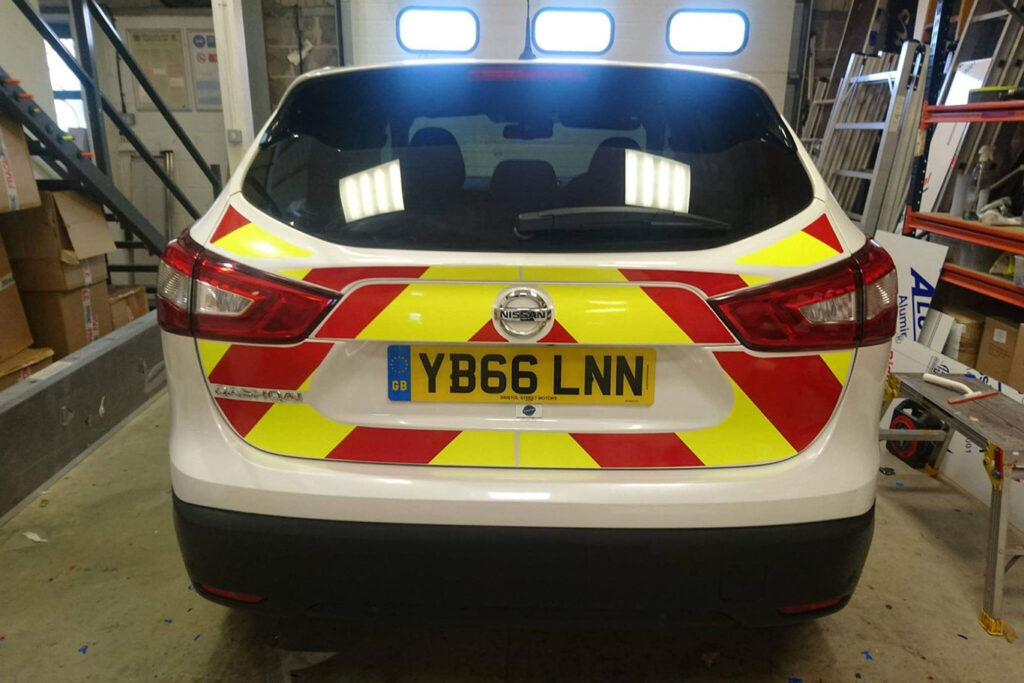No products in the basket.
No products in the basket.

When it comes to fleet safety and compliance, hi vis vehicle markings are a crucial investment. They ensure vehicles remain visible in poor weather and low-light conditions while also supporting compliance with Chapter 8 traffic management guidelines. However, mistakes in applying or maintaining these markings can reduce their effectiveness and compromise safety. This guide highlights the most common pitfalls fleet operators should avoid when fitting hi vis markings to vans, lorries, and other commercial vehicles. With proper planning and maintenance, your fleet can achieve full compliance while projecting a professional image on UK roads.
Not all reflective tapes or chevrons meet UK standards. Choosing low-quality, non-reflective materials can lead to poor visibility, faster wear, and non-compliance. Always select BSI-approved reflective kits specifically designed for commercial use.
Placement is just as important as quality. Chevron panels must be positioned across the rear of the vehicle, covering the full width. Misaligned or partially covered markings reduce visibility and may fail inspections.
Some operators assume that hi vis markings are optional. In fact, Chapter 8 regulations set out strict requirements for vehicles working on UK highways. Missing details such as “Highway Maintenance” text or correct reflective colours can put your fleet at risk of penalties.
Applying reflective markings to a dirty, oily, or damp surface reduces adhesion and longevity. Panels may peel away quickly, creating both a compliance and safety hazard. Always clean and dry surfaces thoroughly before fitting.
Even the best-quality hi vis vehicle markings deteriorate over time. UV exposure, road dirt, and harsh weather gradually reduce reflectivity. Regular fleet inspections are essential, with faded or damaged markings replaced immediately to maintain compliance. Skipping inspections or delaying replacements is one of the fastest ways to risk both penalties and road safety issues.
To avoid these mistakes:
Hi vis vehicle markings are not just about visibility—they’re about compliance, safety, and professionalism. By avoiding common mistakes such as poor material choice, incorrect placement, and inadequate maintenance, fleet operators can ensure their vehicles meet Chapter 8 traffic management standards. Investing in the right markings today protects your drivers, your business, and the public.
For quality hi vis markings and reflective chevron kits, visit All About Chevrons today.
Contact us: 023 9252 0333
Email: info@allaboutchevrons.com
Q1: Do all commercial vans require hi vis vehicle markings?
A1: Yes, any van or lorry operating on public roads for works or traffic management should display compliant hi vis markings to ensure visibility and meet Chapter 8 guidelines. This includes vehicles used by contractors, utility companies, and local councils, where visibility and compliance are critical.
Q2: How long do hi vis vehicle markings typically last?
A2: High-quality markings can last 5–7 years, depending on conditions. Regular checks and timely replacement are essential to maintain full reflectivity. In high-traffic environments, replacement may be required sooner to ensure maximum visibility and continued compliance with UK safety standards.
Q3: Can hi vis vehicle markings be installed without professional help?
A3: Many kits are DIY-friendly, but professional installation ensures correct placement, strong adhesion, and guaranteed compliance with UK road safety standards. For larger fleets, outsourcing installation ensures consistency across all vehicles, saving time and preventing common mistakes with positioning or application.